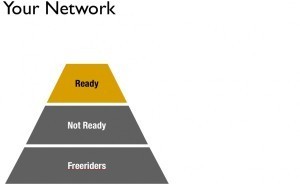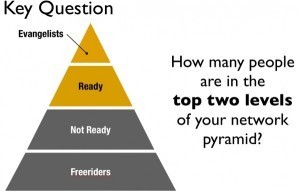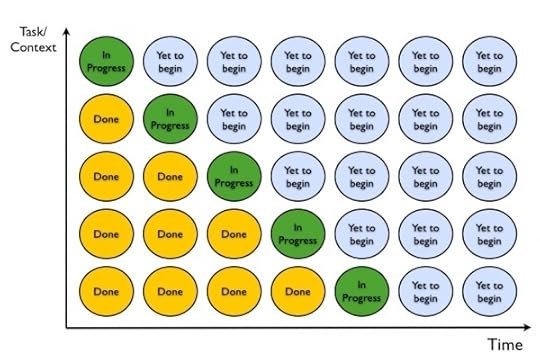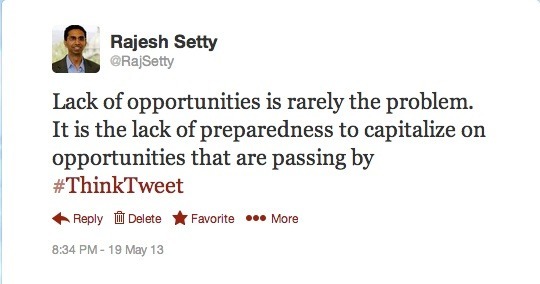Rajesh Setty's Blog, page 6
June 23, 2013
The Instant Immersion Advantage
Immersion in simple terms is deep mental involvement on a topic.
By extension, instant immersion is your ability for deep mental involvement at a moment’s notice.
Building and developing this ability can provide you a huge competitive advantage.
If you are smart, you are switching contexts several dozen times a day. A context switch can be very subtle as you move from:
a. completing that proposal to
b. making that phone call with a potential customer to
c. doing a reference check for potential employee to
d. answering that email where your expertise is called for to solve a problem to
e. taking care of the expense reports
You get the idea. It’s a bunch of things every single day and whether you want or not, if you want to be ultra-successful, you need “instant immersion” to that present context as if you need EVERYTHING you have got to make a masterpiece out of that context.
Why are we not practicing instant immersion now?
Why would we need be instantly immersed in a context?
There are several reasons. Here are a few:
1. We are caught in a trap:
We are in a trap without our knowledge. In most cases, you can get away with a mediocre output or slightly above-average output for a long time in your life – probably until you are forty when the sum of mediocrity catches up to you as a glass ceiling. So, if you can get by with partial attention, why give something complete attention?
2. We think instant immersion takes time:
We forget the “instant” part of the immersion and assume that immersing in anything will take time and time is something that you don’t have.
3. We don’t have the knowledge on how to do it:
This is not a skill that is taught in school. In fact, this was not a skill that was required of you a decade ago. If you don’t know something, how can you be an expert at it?
How can you get started with instant immersion?
Here we go:
1. It starts with awareness:
Like any skill, you need to start off with wanting to do it. The first step is to be aware of the need for that skill. You need to notice the difference between doing something with instant immersion and doing something without that practice.
2. Assign the right label to the current context:
It is hard to be present in the current context if you don’t love to be in there. Imagine you are falling in love with the current context. Imagine it is a huge privilege for you to be even be part of this. What if you considered this as a blessing to have the opportunity to work on whatever it is you are working on?
Did you observe the various labels used:
* love
* privilege
* blessing
* opportunity
Not only you may be using the above kind of labels, your labels may be something like “burden”, “drudgery”, “one more thing to do” etc.
The key is to remember that you have the CHOICE of choosing the label for the current context. It is not AUTOMATIC as much as it sounds like it.
3. Put yourself in the shoes of the person for whom the context matters most
This is the key step.
In general, every context you are entering into will have someone for whom the context matters most. If it is no one but you, then it is your family for whom the context matters most. You “doing well in life” is what they are looking for. And “doing well in life” means “doing well” in each and every context that you are present to. Usually, this makes you to be “present” to the context.
Somethings may seem trivial for you but the context happened because for someone in your life it is NOT trivial.
4. Eliminate the rest for a while
This part is hard as you are constantly bombarded with information from several sources. However, if you practice #3 well, you will find it easy to practice this step. You owe it to those for whom you being the best in this context matters a lot.
5. Gamify, if possible
You need to get this into a habit quickly. We are covering one technique in The Impact Habit but releasing that is a few months out. You can find your own ways to gamify the instant immersion experience. The goal is simple – instant immersion should be your second nature – do whatever you can to get there!
Have a great week ahead!







June 21, 2013
Three clues to spot free riders
Free rider in simple terms is someone who benefits (takes) all the time without ever thinking of paying for what he or she is getting. In other words, free rider is someone who takes the giver for granted.
Free riders are part of your life. You can’t avoid them but if you don’t spot them early, some of them can turn you into a doormat and walk all over you. If you get taken advantage of once, you may be unlucky but you should not forgive yourself if the same person tries to take advantage of you multiple times.
How do you spot free riders in your life?
There are a number of ways – some are more subtle than the others. Here are three clues to start with:
1. Listening for Intent:
Listening has many benefits in general. You won’t have a hard time spotting a potential freerider because their conversations will usually be skewed. Unless you interrupt them and insert a different topic, their topic and focus of interest will be “them” as compared to the “rest of the world.” They might not even ask or care about your interests. It is not that they are not interested, it is that they are indifferent to them.
In their mind, the time they talk about you and your interests is time lost for talking about them and their interests.
2. Make a tiny request and watch for their willingness to help:
Every now and then reach out and make a super tiny request that should take minimum effort on their part to fulfill that request. If it is potential free rider, the response will be very easy to identify. Why? Because at best you will get back a brilliant excuse and at worst, you will get no response.
3. Their story so far
A major clue is their story so far. Whether they are telling you in-person or they have written it somewhere, these stories will have one or more of the characteristics:
* they got to where they are MAINLY with their own effort
* they got little help from others
* luck played no part in their success
and so on.
Wait… Look in the mirror first!
Wait, before you go off and start labeling people in your network with all sorts of things, look in the mirror. Test yourself on the above and make sure that you are not in the same club that you are trying to avoid.







June 20, 2013
How to get your network working
In the world of social media, a network can mean a lot of things. Unfortunately, your network is not equivalent to the sum of all the friends, follower and connections across your social networks. That would be a fantasy.
If we have to over-simplify, your network comprises of people who will care enough to take some positive action for the things that matter most to you AND to some degree you would do the same to them. I qualified it with “some degree” because everything is not always proportional. That is a topic for another article someday
Networks come in various flavors. Some of them are:
* superficial ones on social networks,
* egalitarian clubs where entry is guarded but once you are in – everyone is equal
* regional based on where you came from
* educational – based on where you went to school
* masterminds – like minded people coming together
* diversified but with similar interests – e.g.: Vistage
There are many more but let us assume that you have invested in building a decent network so far. Now, if you are like most people, you are either not able to get the benefit of your network or you are trying but nothing much is happening through the network.
Let us get to the bottom of this.
Nature of your Network
Whether you like it or not, your network comprises of four broad kinds of people, progressively becoming smaller in numbers as you go higher up.
1. Freeriders:
 This will be the largest number of people. It is sad but true. They take from you and… and nothing – it stops there. If you are upset about them, you will be paying twice – once because freeriders introduce COST into your life and twice because you keep thinking about them rather than focusing your energy elsewhere. I am not saying that you need to totally ignore them. If you are operating like a doormat, you are the one to be blamed – there is no excuse for being taken advantage of. You can always learn how to walk away from not-so-good people in your life.
This will be the largest number of people. It is sad but true. They take from you and… and nothing – it stops there. If you are upset about them, you will be paying twice – once because freeriders introduce COST into your life and twice because you keep thinking about them rather than focusing your energy elsewhere. I am not saying that you need to totally ignore them. If you are operating like a doormat, you are the one to be blamed – there is no excuse for being taken advantage of. You can always learn how to walk away from not-so-good people in your life.
To sum it up, keep room for freeriders in your network but remove them from your headspace as that is more precious than anything else.
2. Not Ready:
 These people are better than freeriders but not so much. They acknowledge the help that they have received and probably one fine day they want to reciprocate but that day is not TODAY. Today, they are busy with their own set of problems and issues or they are busy chasing opportunities and that is taking up more time than they have. Fundamentally, if they don’t forget your help by then, a day will come when they have taken care of all their needs and they can look to take care of the needs of others. Sometimes there are people who genuinely are not able to reciprocate because of their personal situations. Whatever be the case, these are people that you cannot count on TODAY. They are “not ready” to give back for all practical purposes.
These people are better than freeriders but not so much. They acknowledge the help that they have received and probably one fine day they want to reciprocate but that day is not TODAY. Today, they are busy with their own set of problems and issues or they are busy chasing opportunities and that is taking up more time than they have. Fundamentally, if they don’t forget your help by then, a day will come when they have taken care of all their needs and they can look to take care of the needs of others. Sometimes there are people who genuinely are not able to reciprocate because of their personal situations. Whatever be the case, these are people that you cannot count on TODAY. They are “not ready” to give back for all practical purposes.
3. Ready:
 They are willing and ready to help BUT with one caveat – you have to ASK them to help you. They are fully charged and ready to go but they are not activated. In fact, they might even offer you help if they see you struggling with something but it has to be something obvious – something they can see and touch. Some people may also think that you don’t need a lot of help so why “intrude” in your life. They think you know that they can always be counted on and you WILL ask them if you ever needed your help. These are people who are one phone (or maybe two) phone call(s) away and you just have to reach out to that phone and dial for them IF you want them for something.
They are willing and ready to help BUT with one caveat – you have to ASK them to help you. They are fully charged and ready to go but they are not activated. In fact, they might even offer you help if they see you struggling with something but it has to be something obvious – something they can see and touch. Some people may also think that you don’t need a lot of help so why “intrude” in your life. They think you know that they can always be counted on and you WILL ask them if you ever needed your help. These are people who are one phone (or maybe two) phone call(s) away and you just have to reach out to that phone and dial for them IF you want them for something.
4. Evangelists:
 These people have got your back. They are there for you whether you want them or not. You and what you care about is in their mindspace all the time – they look out for you even when you are not looking out for yourself. They are thoughtful and caring for almost everything you care about. Some of the people here are the ones that you miss in your past. Your life is better off in many ways because these people exist in your network.
These people have got your back. They are there for you whether you want them or not. You and what you care about is in their mindspace all the time – they look out for you even when you are not looking out for yourself. They are thoughtful and caring for almost everything you care about. Some of the people here are the ones that you miss in your past. Your life is better off in many ways because these people exist in your network.
Trap Alert: Note that because these people are so proactive, it is easy for you to take them for granted or worse, take advantage of them. That would be a big mistake – both in the short-term and in the long-term. The best way to avoid this is to practice stoicism (another article one day) but the next best way is to just be more aware of all the blessings in your life. Evangelists in your network pyramid are and always will be a blessing.
The Key Observation
 So, with that in the background, here is the first observation:
So, with that in the background, here is the first observation:
Your leverage from your network is directly proportional to the number of people at the top of your pyramid AND your finesse of making thoughtful requests to those folks in the second section of your network pyramid.
You can conveniently ignore the bottom two sections of your network pyramid as nothing good will come out of it. The more you shift your focus away from these sections, the more you will have peace in your life.
The Real Question:
The real question is about you and not about your network. Read this question carefully and reflect on it:
For how many people in your network are YOU on the top level of their network pyramid?
The higher the number, the better the stats for your own network pyramid. This is where the magic is. If you want to get your network to get working, you better be one of those people who make the network of others get working for them. It starts with YOU always – if you are in the top section of someone’s network pyramid, you need to have an uncommon caring for what they care about. If you learn to do have this level of caring without sacrificing your own interests – you have found the winning formula (Side Note: That is one of the things I teach in The Art of Leverage)
So, before you start looking for reasons why you are not able to make your network work, start looking for ways to make the networks for others “work” for them. Do this well and watch the magic unfold.







June 19, 2013
The Impact Habit Survey
 My work is such that I routinely meet people who want to make a giant-sized impact on this world. These people super competent and at least on-the-face committed to see through their dream. Some of them are even tinkering with ideas here and there to get started.
My work is such that I routinely meet people who want to make a giant-sized impact on this world. These people super competent and at least on-the-face committed to see through their dream. Some of them are even tinkering with ideas here and there to get started.
Those of you who have been following me know that I have only two kinds of relationships
Long-term and
Very long-term
Because of that approach, I get to meet many of these people over the years. Sadly, a large number of these competent people don’t end up “making any dent in the universe” but have become masters of coming up with “believable excuses.”
This has been bothering me for a while.
So, when I teamed up with Bill Sherman (my very long-time friend) to write my next book, the question that we wanted to address was:
Why do competent people often accomplish very little?
After months of work, analysis and interviews, we are in the final leg of the journey. The title of the book (as you might have guessed) is The Impact Habit.
Now, a request to all of you:
We have a draft website up and running. Most importantly, we have a survey that will take less than 4-minutes to complete and I would love your help. More people take the survey, better are the results. There are more than 200 people who have taken the survey and we need a few hundred more.
Please help by taking this survey and if possible, forward this to any other friends that are willing to help with this project
http://www.theimpacthabit.com (4-minute survey)
Thanks and have a great day!
**UPDATE** Thanks for the overwhelming response to the survey. We have more than 500 professionals from all over the world completing the survey. We welcome more but Bill and I already feel blessed with all your support.
Photo Courtesy: Renee Hawthorne







June 13, 2013
How to prepare to be an entrepreneur
There are fairy tale stories that get reported in the media about the glorious life of an entrepreneur. The details are generally missing as it would be impossible to document the ups and downs of an entrepreneur throughout his or her journey. That would drive the reader insane for sure. The journey in simple terms is akin to a “wild” roller coaster ride in the dark.
This article is for people who are thinking of becoming entrepreneurs. Think of it like a Pre-Entrepreneurship Crash Course. I am not going to cover things that are super obvious but will focus on those areas that are subtle and might easily be overlooked
(These are in no-particular order and the list is not complete)
1. Learn to keep promises to yourself:
Forget for a second about the promises that you make to others – you need to learn to keep the promises that you make to yourself. When you are an entrepreneur, you will make lots of promises to yourself (sometimes nobody will be listening to you – so you can’t make promises to others) and the only way you can get through to the next stage is by keeping those promises that you make to yourself.
2. Learn to be likable:
Being likable is harder than you think. The immediate temptation is to think about pleasing others as the easiest path to be likable. Being smart, you know that it won’t work and most probably it will backfire anyway. To keep this short, here are a few quick tips:
2.1 If you want to be likable, genuinely care for others. Care as if their problems are your own. If you are genuine, it shows. If your not genuine, it shows even more.
2.2 Be an energizer. Do you leave other people energized or do you suck the energy out of them. If you are doing the former, it would be impossible to be likable.
2.3 Don’t take yourself seriously. If you do, you will be worried more about you then caring for others.
Why should you be likable? Simple answer: It is easier to get things done if you are than when you are not. As an entrepreneur, you will have to get more things done with less resources as compared to someone who is having a job.
3. Learn to build lasting relationships:
If you are thinking about someone only when you need something from them, you have got it all wrong completely. A lasting relationship at the core is about enrichment. Are you both mutually being enriched as a result of the relationship? If not, the relationship may last only as long as it is convenient to keep it alive.
As an entrepreneur, relationships are your currency and treat them as such. If you have learned to build such relationships and already have built lots of them before you jump on the entrepreneurship bandwagon, life will be a bit simpler compared to the alternative.
Free eBook: Lasting Relationships
4. Build a personal brand:
Whether you want or not, your personal brand will add weight age to your message. There is a fine line between telling your story and showing off. Choose the former and you will pay the price of diluting your personal brand rather than enhancing it.
A note of caution: Because “personal branding” is such a cliched term, you may be tempted to build a brand on social media channels as there are gurus out there who are telling how to use all the social networks to amplify your brand. The keyword to watch here is – “amplify”. If you don’t have valuable accomplishments, there is nothing to amplify. Personal brands are first built on valuable accomplishments and then amplified through variety of channels that are available. The order is important.
Free eBook: Personal branding for technology professionals
5. Lead a volunteer effort where you are accountable for the results:
The best way to test your influencing skills is to lead a volunteer effort where:
a) you need to signup for some measurable results (e.g.: raise $XX funds
b) recruit volunteers
c) plan and execute the campaign to meet or exceed the results
If you can recruit and lead a team of volunteers and keep them motivated until the results are achieved, you would have learned a host of things that will serve you well in your entrepreneurship journey.
6. Make powerful requests:
In short, a powerful request does not come across as a request at all – it appears like an opportunity for the other party. Your ability to transform a request and convert that into an opportunity on the fly will serve you well later during your entrepreneurship journey. Remember that people are flooded with requests but are starved on opportunities. You are a minority in their life if you are bringing them thoughtful opportunities. That’s the fastest way to get people on your side.
7. Learn to reframe your questions:
Reframe as the name indicates is to look at something from a different angle. Here are a few questions and the reframed versions of the same:
7.1 Get vs Become (courtesy: Jim Rohn)
What am I getting?
Who am I becoming?
7.2 Victimization vs Accountability
Why is this happening to me?
How am I contributing to this?
or
What am I learning from this?
7.3 Ecosystems and Choreography
How can I get this done?
What is the right combination of (available) resources to execute this in the most optimal fashion?
7.4 Identity
Do I matter?
How do I matter?
8. Learn the fundamentals of storytelling:
This is a MUST whether you want to be an entrepreneur or not but if you WANT to be an entrepreneur, mastering this art will give you a huge competitive advantage. Storytelling skills are not required just when you are on the stage or when you are giving an elevator pitch to someone. It is required whenever you want to talk about your startup – even during a casual conversation with ANYONE. We as human beings operate on stories – the ones that we tell, ones that we tell ourselves and the ones that we hear from others.
Please read: How to weave a story around your startup?
9. Make meaningful and measurable contributions to other startups:
A startup looks very different from outside but it’s another world once you are in it. If you have never been part of one and try to start one, you will be in for a big surprise. One way to be “less” surprised is to avoid the sandbox and actually get involved in startups (for free) and make meaningful and measurable contributions to their growth. You will be trading time for the experience – it will the best investment you would have made in preparation to your own entrepreneurship journey.
The side benefit of this approach is that you are also building “good karma” along the way and one day it will pay back in ways that you can’t imagine.







June 4, 2013
How to decide what to learn next
I still remember that meeting. I was in my high school and one of my Uncle’s friends had come to our home. My Uncle thought his friend was “special” because his friend had a bachelors degree in Arts, Commerce and Science. It seemed like a naive question but because I was young, I asked the question anyway – “But why would you want to have degrees all three disciplines.” and the answer was “Because I can.” He then handed over the card that read something like this
FirstName LastName
B.A., B.Sc., B.Com
A degree in three disciplines gave ZERO advantage to the person referred above. It was more of a liability than an asset.
Why?
While it appeared “cool” at first, it added no strategic value to anyone he was serving.
I was definitely puzzled a bit about this person but forgot about it after a while.
Fast forward a couple of decades and I get to witness a similar phenomena. It may not to an extreme like the above example but somewhere close. I have met people who have taken courses that makes no sense, spent a few hundred thousand dollars on an MBA program that they have leveraged very little or simply painted their entire home by hand because they wanted to show that they can do it.
That brings to the core question:
How do you know what to learn next?
The rest of the article provides an approach to find an answer for the above plus a few actionable tips.
Let’s get right to the core of it. Learning is not limited to what you do explicitly to become proficient on a certain topic. Every single day you are learning as you work through your projects. So “learning” encompasses both what you do explicitly and what projects you are engaged with.
It is always about the balance between increasing current leverage with “relevant” future capacity
Wayne Gretzky said it right – “I skate to where the puck is going to be, not where it has been.” It is not just relevant to the game but to all of our careers.
Ideally, your skill sets should be such that you need to stretch a “little bit” to get the better and faster results (compared to the majority of the available options). The reason for the need to “stretch a little bit” is mainly because that is where the growth is. This simply means that you need to pick projects that are one or two notches harder than before every single time. The second reason for this is that alternatively you will be bored to death by doing repetitive work. Most people get this part quite well.
The other aspect to “learning and working” is that both of them should lead to increasing your capacity to deliver stellar performance in the future. This is not easy because it requires deep thinking and reflection on what kind of skills will be required to deliver stellar performance in the future. This requires taking risks as you are probably not a “futurist” to predict how the world around you will evolve. Without the skills of a futurist, the alternate option would be to over-prepare with additional skills as backup. If you are not doing this right, sooner than later, you will face the Hemingway’s classic “Gradually.. Then Suddenly” surprise.
You can never go wrong with the fundamentals
Change is happening at a breathtaking speed but there are skills that are fundamental and an investment in them will never go wrong. A partial list of these skills is listed below:
(A detailed explanation of each is outside of the scope of this article)
How to build and maintain meaningful relationships (Download Lasting Relationships eBook)
How to tell a great story (Read: How to weave a story around your startup)
How to build your brand (Download Personal Branding for Technology Professionals)
How to craft a powerful narrative (Read: How to CRAFT a conversation that moves the needle)
Learn to distinguish yourself (Download: 25 Ways to Distinguish Yourself)
Creativity – you can never get enough of it (eg: How to design business cards that make you think)
How to read a non-fiction book (blog post)
How to check your ego at the door (Take the 3-minute Ego Test)
Being prepare for Act 2 ( blog post )
Learning to disagree gracefully (blog post)
Learning to identify and grow your strengths (Read: 7 Ways to Identify Your Strengths)
Mastering the fundamentals of leverage (Course: The Art of Leverage – Request an invitation)
Being Likeable (A chapter in Beyond Code – free download)
There are a lot more skills to add to the list. Unfortunately, not all of these highly-valuable skills are not taught in school. You learn them as you go because your work requires you to OR you can consciously choose to identify a set of them and pursue their mastery.
Watch the right progress metric
There are so many metrics (money being the most common one) to track and you can get carried away. But if you are learning right, you will notice one thing very clearly if you are learning the right things is:
It will cost you less to get the same or better results (and to contribute more) as compared to what it costed you last year.
This metric will account for the change in the marketplace. This metric becomes a better indicator as you age. And, the best part is – the opposite is true as well. If you are not learning the right things, you will notice that
It will cost you more to get the same or better results (and to contribute more) as compared to what it costed you last year.
Since it’s very personal, only YOU can track this metric in the right way.
Get the right mentors NOW
In a recent radio show, Srini Saripalli asked me a closing question – “If you were to live your life all over again, what would you change?”. My answer was simple – “Nothing much as I am happy with my life so far. If I HAD to pick one, it would be that I met all my mentors a few years before I met them.”
I miss many of these wonderful people who shaped my life. In fact, I miss them in my past.
[ Related reading: Creating the ultimate lasting impression]
The right mentors at the right time can create magic for you. In your ongoing conversations with these mentors you WILL know how to decide what to learn next.
If you need reasons to work with mentors, here are ten of them.
Getting it done while you are not “working”
This is some combination of a mindset and a skill. If you are investing in the right skills and shaping your mindset right, sooner than later, you will start getting things done while you are not “working.” For the world, you ARE working but for you, it’s play. It stopped “being work” the moment you started losing track of time when you are engaged in that work.
Both parts are important:
Part 1: Getting things done (meaning you need to be producing meaningful results)
Part 2: While you are not working (you should enjoy the work so much that you lose track of time)
If Part 1 is missing, there is a slight chance that you are confusing work and entertainment.
What gets challenging is for you to identify what you need to learn so that you can be in “flow” in the future. Your gut will tell you what those skills are – you just need the confidence to trust that gut.
The Ideal Combination
There are set of skills that will provide the ultimate combination: helping you produce better results in the short-term AND providing you ”future capacity” to gain unfair competitive advantage.
For example – one lifelong skill that will fall into the above-mentioned category is “presentation skills.” Learn this and your current projects can be packaged and presented well. Since it takes years to master the skill, it will provide you “future capacity” to gain unfair competitive advantage. For someone else to gain competitive advantage in this area, they have to PAY the price over the years. There is NOBODY who can learn such skills overnight. The earlier you start, the greater your advantage.
A Better YOU…
Ultimately, it boils down to one final question – does learning this skill make you a better YOU – not just for your sake but for the sake of the world around you. If your heart signs off on this litmus test, go for it!







June 2, 2013
The Invisible Power of Competence Plus Calmness
Think about someone who is competent AND calm. The combination immediately provides signs of confidence. They tell the world that they will have the current situation mostly covered – one way or the other.
Calmness without competence won’t help much because it might just send a message that they are not serious about their life or work or both
Competence without calmness might might signal hubris or over-confidence or in some cases plain uncertainty
One of the keys to gain unfair competitive advantage is to practice being calm and one of the keys to being calm is to not be on a quest for gaining unfair competitive advantage.
Faking calmness seems easy but it only works in the short-term.
Staying calm is easy in theory but it takes years of practice to get there (more on this later in this article)
Faking competence seems easy but it only works in the short-term.
Staying competent on any topic requires a lifelong investment in yourself in addition to having great mentors and a supportive network in that space. And, in addition, you need to be working on projects related to that topic so that you get the real-world skills. Reading a book on a topic rarely gives you the complete education to stay competent and current on the topic.
A combination of competence and calmness is also not automatic and it’s something you have to “work” to build.
The combination of competence and calmness happens internally first and is witnessed by others rather than the other way around. It’s an inside-out approach. This is not something that you will fake it till you make it.
How do you develop this combination?
There is no shortcut to develop this combination but here is an approach that few of us are taking. It is still a work-in-progress but early results are encouraging:
1. Select the Skills:
Pick one or two skills where you need to develop competence. Yes, you and I know that there is a good chance that you are competent in MANY skills but DEPTH requires choice (to pick a few skills) and sacrifice (to push other skills to the sidelines as “also ran”s)
2. Select the Market:
Find out who needs the benefit of these skills to move the needle on their projects. It seems hard at first because those people who needs the benefit of these skills may not be aware of you or your ability to help them. But this keeps getting easier as time progresses as you build social proof. Ideally, tribal knowledge in your circles should treat you as the default go-to-person for your knowledge of these skills.
3. Take Action that Matters:
Lend your skills (need not be for free but surely at a discounted rate at first) and move the needle. This step is important as the more you do it, the more you will be on the path to develop calmness. You lose your calmness generally when you don’t have a sense of control on the situation. It is impossible for you to get that sense of control in any NEW situation UNLESS you have faced MANY such situations in the past. This is when your “background of obviousness” is so rich that you become comfortable with the uncomfortable – not 100% but enough to keep you calm.
[ Related reading: How to Stay Calm ]
4. Build your Support Network in Parallel:
In parallel, go and find the mentors and other people you need to network within the space and start amplifying work that matters from these people. You don’t need to reach out to them or “friend” them. You WILL be discovered sooner than later if you amplification that you bring to the table is reasonably big.
My Example: Amplification Choreography
For me personally, one of the skills I decided to focus on can be summed up as Amplification Choreography. It is to take a concept, idea, product or service and choreograph its amplification creatively and within the constraints imposed by the situation. Constraints increase the difficulty on one end but on the other end, constraints are what brings out the best of our creativity. Via Foresight Plus, I get to meet and work with really smart people on their ideas. Whatever form or shape they bring their ideas, in general they are looking at one and only one thing – to amplify what they have. Amplification Choreography provides a reasonably satisfactory answer to them. It is a true win-win as the more we help people via amplification choreography, the better I and my team become in that skill. Needless to say, this is also an area where I build my own network as it directly positively impacts all the projects (both for-profit and non-profit) projects that I am involved with.
A quick non-profit example is here: How to Design a Touching Thank You Card







May 24, 2013
Sergey Brin on Google Glass – Making a case (or not)
Let me first make a case for not cutting your hand by a knife? You should just prick your hand with a needle. It is less painful and you will probably bleed less.
Does the above make sense?
Probably not.
Now, how about making such a case for Google Glass?
Watch this video where Sergey Brin makes a case starting at 2:45
[ Note: I respect Sergey Brin for all the awesome work so these comments are only based on a particular storytelling incident ]
Click here to view the embedded video.
Sergey explains that people keep looking at their smartphones while having conversations and it’s distracting and that’s one of the reasons behind the Google Glass project. You see, with Google Glass they don’t have to look down and get distracted.
Really?
Yes, you can get distracted without even looking somewhere else.
Making a case for the sake of making one won’t cut it, unfortunately.







May 19, 2013
Are you ready to do something special?
Before I go any further, watch these two videos that will set the context for this article. While there is a chance that this may be staged, the point is to focus on the lesson on not on winning a debate that will lead to nothing.
Video #1: Pumpcast News, Part 1 – The Tonight Show with Jay Leno
This is a short video (5 minutes) where Jack Rafferty surprises a cool couple (husband is a bartender and wife is a fitness instructor)
Click here to view the embedded video.
Video #2: Pumpcast News, Part 2 – Happy Couple on The Tonight Show with Jay Leno
Jay Leno invites the happy couple from the Pumpcast News to play with the band
Click here to view the embedded video.
While the entire thing was pure fun and entertainment, there are a couple of lessons to be learned from this. The key ones for me are:
1. Are you ready to do something special?
Opportunities don’t come packaged and delivered on a set date. They come abruptly and out of the blue. You rarely can capitalize on them unless you are ready for them – meaning you should have invested enough in yourself such that a moment’s notice is all that’s required to bloom. As we both know, it’s never the lack of opportunities but the lack of preparedness to capitalize on opportunities that are passing by.
2. Being comfortable with who you are
Yes, it is difficult to be like someone else but it’s harder to be just YOU. It was very clear that the couple were super comfortable with who they were. What you need to be careful is not to confuse “being comfortable with who you are” with “complacence.” The world where we live requires you to be moving fast just to stay where you are.
3. Small wins are cool (sometimes they lead to bigger wins)
Notice how this all started – Jack Rafferty offers the husband free tank of gas if he sings. That “small win” was more than enough for the husband (and later his wife) to sing his heart out. Of course, the big win was to get on the Jay Leno show but that was not the reason for both the husband and wife to participate in the “game”
Have a great week ahead.







May 11, 2013
Six Simple Growth Equations
I was advising a young student who is getting into his first real job and wanted to keep everything plain and simple. The outcome was the following six simple growth equations.
1+1 = ?
This is where you are working without a purpose. You don’t know what you want in life so you are confused whether you are growing or sliding sideways. The anxiety to “get things right” robs a lot of your growth.
1+1 = -1
This is where you make dumb career decisions such as focusing on personal gain at the expense of relationships. You take advantage of people forgetting that you don’t lose a person but a relationship network. This is a no-win strategy.
1+1 = 0
This is where you work to ensure that you keep your job for the next year and nothing else. Since you are doing “just enough” you escape from the axe but since you are not “growing” sooner than later, disaster strikes.
1+1 = 1
This is where you are adding one year of experience with another year of experience. In other words, you don’t bring the power of your first experience to the second year to enrich the second year experience and so on. This problem is way more prevalent than what
1 + 1 = 2
As simple as it sounds just getting here will put you in the “above average” category as you are building up your experience every year. In a short-span of ten years, you will be miles ahead of your peers if you keep up the attitude and approach towards learning.
1+ 1 = 11
This is where the magic of leverage comes. In this case, not only are you learning but you are also “giving” so that others around you are improving on the equation. You ensure that nobody around you is below the 1+1=2 equation. So, sooner than later, you would have built a small army of people who have vested interest in helping you succeed big time. Knowingly or unknowingly you are filling in the reservoir filled with the power of reciprocation.
Bonus Equation: 1+1 = !
This is where you take your experience from work AND mesh it with uncommon investment in yourself to create something remarkable. Remember that all said and done you have limited control on what your experience will be in the first few years of your career but you have unlimited control on how much you can invest in yourself. Taking advantage of that is where all that magic is.
Please take a moment to share this with anyone in your network who is starting their career.







Rajesh Setty's Blog
- Rajesh Setty's profile
- 6 followers











